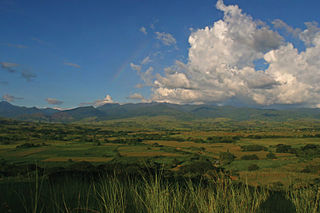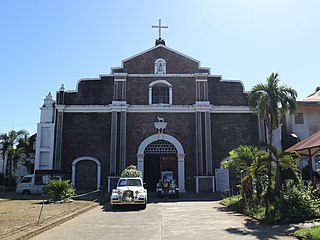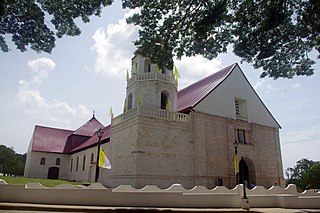
Isabela, officially the Province of Isabela, is the second largest province in the Philippines in land area located in the Cagayan Valley. Its capital and the largest local government unit is the city of Ilagan. It is bordered by the provinces of Cagayan to the north, Kalinga to the northwest, Mountain Province to the central-west, Ifugao and Nueva Vizcaya to the southwest, Quirino, Aurora and the independent city of Santiago to the south, and the Philippine Sea to the east.

Boljoon, officially the Municipality of Boljoon, is a 5th class municipality in the province of Cebu, Philippines. According to the 2020 census, it has a population of 17,525 people.

Lazi, officially the Municipality of Lazi, is a 4th class municipality in the province of Siquijor, Philippines. According to the 2020 census, it has a population of 22,488.

Cabagan, officially the Municipality of Cabagan, is a 1st class municipality in the province of Isabela, Philippines. According to the 2020 census, it has a population of 53,897 people.

Tumauini, officially the Municipality of Tumauini, is a 1st class municipality in the province of Isabela, Philippines. According to the 2020 census, it has a population of 70,743 people.

Loboc, officially the Municipality of Loboc, is a 4th class municipality in the province of Bohol, Philippines. According to the 2020 census, it has a population of 17,418 people.

The Baroque Churches of the Philippines are a collection of four Spanish Colonial-era baroque churches in the Philippines, which were included in UNESCO's World Heritage List in 1993. The churches are also considered as national cultural treasures of the country.

Saint Augustine Parish Church, commonly known as Paoay Church, is a Roman Catholic church in the municipality of Paoay, Ilocos Norte in the Philippines. It is under the jurisdiction of the Diocese of Laoag. Completed in 1710, the church is famous for its distinctive architecture, a highlight of which is the enormous buttresses on the sides and back of the building. It is declared as a National Cultural Treasure by the Philippine government in 1973 and a UNESCO World Heritage Site under the collective group of Baroque Churches of the Philippines in 1993.

Saints Peter and Paul Parish Church, commonly known as Calasiao Church, is a Baroque church located in Poblacion West, Calasiao, Pangasinan, Philippines. It belongs to the Vicariate of Sts. Peter and Paul under the Ecclesiastical Province of the Roman Catholic Archdiocese of Lingayen-Dagupan. The 57,840 Catholics is under the pastoral care of Rev. Fidelis B. Layog, assisted by Rev. Isidro Palinar, Jr. and Rev. Raymund Manaois.

Santo Tomás de Villanueva Parish Church, commonly known as Miagao Church, is a Roman Catholic church located in Miagao, Iloilo, Philippines. It is under the jurisdiction of the Archdiocese of Jaro. The church was declared as a UNESCO World Heritage Site on December 11, 1993, together with San Agustin Church in Manila; Nuestra Señora de la Asuncion Church in Santa Maria, Ilocos Sur; and San Agustin Church in Paoay, Ilocos Norte under the collective title Baroque Churches of the Philippines, a collection of four Baroque Spanish-era churches.

Saint Andrew the Apostle Parish, commonly known as Bacarra Church, is a Roman Catholic church located in the municipality of Bacarra, Ilocos Norte, Philippines under the jurisdiction of the Diocese of Laoag.

Immaculate Conception Parish Church, also known as La Purisima Concepcion de la Virgen Maria Parish Church and Baclayon Church, is a Roman Catholic church in the municipality of Baclayon, Bohol, Philippines within the jurisdiction of the Diocese of Tagbilaran. Baclayon was founded by the Jesuit priest Juan de Torres and Gabriel Sánchez in 1596, and became the oldest Christian settlement in Bohol. It was elevated as a parish in 1717 and the present coral stone church was completed in 1727. The Augustinian Recollects succeeded the Jesuits in 1768 and heavily renovated the church since then.

San Pedro Apostol Parish Church, commonly known as Loboc Church and alternatively as the Diocesan Shrine of Our Lady of Guadalupe in Extremadura, is a Roman Catholic church in the municipality of Loboc, Bohol, Philippines, within the jurisdiction of the Diocese of Tagbilaran.

The Archdiocesan Shrine of Patrocinio de Maria Santisima, commonly known as Boljoon Church, is a Roman Catholic church dedicated to Our Lady of the Patronage in the municipality of Boljoon, Cebu, Philippines, under the Archdiocese of Cebu.

Immaculate Conception Parish Church, commonly known as Guiuan Church, is a Roman Catholic church in the municipality of Guiuan, Eastern Samar, Philippines, within the jurisdiction of the Diocese of Borongan.

San Isidro Labrador Parish Church, commonly known as Lazi Church, is a Roman Catholic church in the municipality of Lazi, Siquijor, Philippines within the jurisdiction of the Diocese of Dumaguete. It became an independent parish in 1857 under the advocacy of Saint Isidore the Laborer.
Philippines National Historic Landmarks is a registry of historic sites in the Philippines that have been officially declared by the Philippine Registry of Cultural Property.

Isabela's 1st congressional district is one of the six congressional districts of the Philippines in the province of Isabela. It has been represented in the House of Representatives since 1987. The district consists of the capital city of Ilagan and the northern municipalities of Cabagan, Delfin Albano, Divilacan, Maconacon, San Pablo, Santa Maria, Santo Tomas and Tumauini. The municipality of Palanan was part of this district until it was redistricted to the 2nd district, effective in 2019. It is currently represented in the 19th Congress by Antonio T. Albano of the Lakas–CMD.

San Pablo Church is ruined Roman Catholic church located in San Pablo, Isabela, Philippines. The church was built in 1624, making it the oldest in Isabela.
























